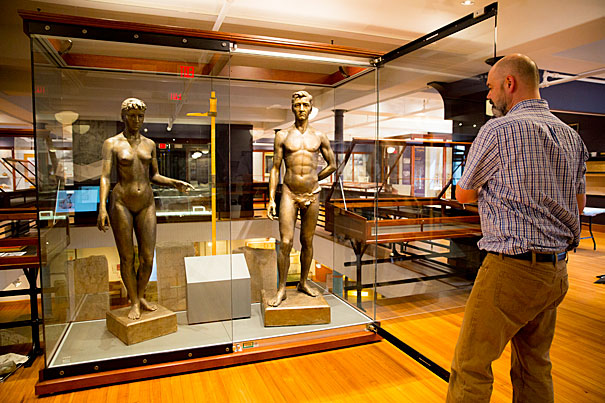Harvard Arts and Culture Exhibits: A Transformative Experience
Harvard Arts and Culture Exhibits provide a vibrant intersection of creativity and advocacy, showcasing powerful narratives that resonate deeply with the community. The latest exhibition, “Seeing Each Other: A Conversation Between the Harvard Foundation Portraiture Project and Americans Who Tell the Truth,” features stunning portraits from the Shetterly portrait series, highlighting female changemakers who have made significant strides in advocacy and social justice. This initiative exemplifies the essence of art as a tool for storytelling, revealing the often-overlooked voices that shape our world. With artists like Robert Shetterly and the impact of the Harvard Foundation Portraiture Project, these exhibits encourage viewers to reflect on the importance of representation and the courageous acts of individuals who stand for change. By immersing oneself in these artworks, attendees are invited to consider the power of seeing each other and the role of art in advancing equity and understanding.
The Harvard Arts and Culture Exhibits play a crucial role in elevating diverse stories and fostering dialogue within the community. This latest showcase features influential female leaders who have made remarkable contributions to society, reflecting the dynamic interplay between visual arts and the narratives of social change. Through engaging displays like the Shetterly portrait series and perspectives from the Harvard Foundation Portraiture Project, attendees can explore themes of representation, courage, and advocacy. These exhibits not only celebrate the achievements of female changemakers but also invite viewers to engage in a critical conversation about equity and justice. Ultimately, the intersection of art and advocacy within these exhibitions highlights the transformative potential of cultural expression.
The Impact of Portraiture in Arts and Culture
Portraiture serves as a powerful medium to convey stories that often remain unheard in the grand narrative of history. Through the lens of portraiture, artists like Robert Shetterly and Stephen Coit have explored themes of advocacy and social justice, as seen in their contributions to the Harvard Foundation Portraiture Project. By choosing to depict individuals who have made significant contributions in various fields, this method elevates the conversations surrounding representation and equity. The portraits invite viewers to examine their own perceptions of courage and resilience, making art a vehicle for both personal reflection and societal change.
The installation of exhibitions, such as ‘Seeing Each Other,’ bridges the gap between artistic expression and historical narratives of overlooked figures. By creating an immersive experience where viewers can engage deeply with each piece, the portraits act as a calling to acknowledge and celebrate the lives of these changemakers. This is evident in the honoring of female figures in the current exhibition, emphasizing how art can shine a light on women’s contributions to movements for equity and justice.
Frequently Asked Questions
What are the key themes of the Harvard Arts and Culture Exhibits featuring the Shetterly portrait series?
The Harvard Arts and Culture Exhibits, particularly those featuring the Shetterly portrait series, revolve around themes of hope, change, and the importance of representation. They aim to elevate overlooked voices and highlight the courage of individuals who advocate for social justice, as exemplified by the portraits within the ‘Seeing Each Other’ exhibition.
How does the Harvard Foundation Portraiture Project contribute to Harvard Arts and Culture Exhibits?
The Harvard Foundation Portraiture Project enriches Harvard Arts and Culture Exhibits by focusing on representation and diversity. It showcases the stories of influential individuals, particularly female changemakers, thereby fostering a deeper conversation around social justice and advocacy, and enhancing the educational experience of visitors.
What is the significance of the ‘Seeing Each Other’ exhibition in the context of Harvard Arts and Culture?
The ‘Seeing Each Other’ exhibition is significant within Harvard Arts and Culture as it combines the efforts of the Harvard Foundation Portraiture Project and Robert Shetterly’s work to create a dialogue about gender equity and representation. By displaying portraits of impactful figures, it seeks to inspire change and reflection on societal issues.
What role do female changemakers play in the Harvard Arts and Culture Exhibits?
Female changemakers are central to many Harvard Arts and Culture Exhibits, particularly in the portrait series by Robert Shetterly and the Harvard Foundation Portraiture Project. These exhibits highlight the contributions of women who have shaped history and advocacy, providing visibility to their stories and emphasizing the importance of gender equity.
How can visitors engage with the art featured in Harvard Arts and Culture Exhibits like the Shetterly portrait series?
Visitors to Harvard Arts and Culture Exhibits can engage with the art, including the Shetterly portrait series, by taking the time to observe the details of each piece and reflecting on the stories behind them. The use of quotes incorporated into the portraits invites viewers to slow down and connect with the courageous narratives depicted, enhancing their appreciation for art as a form of advocacy.
| Key Points |
|---|
| Artist Robert Shetterly’s work focuses on social justice through portraits, creating dialogue about underrepresented voices. |
| The exhibition, titled “Seeing Each Other,” features portraits celebrating female changemakers and emphasizes the importance of advocacy. |
| Shetterly’s technique integrates quotes from subjects, encouraging viewers to deeply engage with the artwork. |
| Harvard’s collaborative celebration of diverse voices illustrates the enduring impact of art in social movements. |
Summary
Harvard Arts and Culture Exhibits highlight the power of art as a medium for social change by presenting diverse voices and experiences. The recent exhibition featuring portraits by Robert Shetterly and others reinforces the importance of representation and dialogue in the pursuit of gender equity and justice. By letting these portraits speak through their subjects’ powerful messages, the exhibit encourages viewers to engage more deeply with the stories behind the faces and cultural narratives that shape society today. This initiative exemplifies how Harvard Arts and Culture Exhibits can inspire hope and promote a shared responsibility towards advocacy and social awareness.
